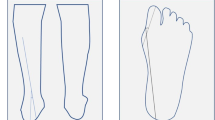Abstract
The foot is a common source of parental concern and consultation with a primary care physician. The majority of foot conditions are benign and do not need specific treatment and only rarely is there a serious cause. A thorough understanding of normal foot development and physiological variations is essential to assess a paediatric foot and identify rare pathological conditions.
Occasionally the cause of foot problems lies within the entire lower limb or spine. In this chapter, we will discuss common orthopaedic conditions and how to approach them, common pitfalls in assessment and how to stay out of trouble while dealing with parents or carers.
Access this chapter
Tax calculation will be finalised at checkout
Purchases are for personal use only
Similar content being viewed by others
References
Bosch K, Gerss J, Rosenbaum D. Preliminary normative values for foot loading parameters of the developing child. Gait Posture. 2007;26(2):238–47.
Diab M, Staheli LT. Practice of pediatric orthopaedics. 3rd ed. Philadelphia: Wolters Kluwer; 2015.
Bosch K, Gerss J, Rosenbaum D. Development of healthy children's feet--nine-year results of a longitudinal investigation of plantar loading patterns. Gait Posture. 2010;32(4):564–71.
Staheli LT. Planovalgus foot deformity. Current status. J Am Podiatr Med Assoc. 1999;89(2):94–9.
Mubarak SJ, Patel PN, Upasani VV, Moor MA, Wenger DR. Calcaneonavicular coalition: treatment by excision and fat graft. J Pediatr Orthop. 2009;29(5):418–26.
Rodriguez N, Choung DJ, Dobbs MB. Rigid pediatric pes planovalgus: conservative and surgical treatment options. Clin Podiatr Med Surg. 2010;27(1):79–92.
Sullivan JA. Pediatric flatfoot: evaluation and management. J Am Acad Orthop Surg. 1999;7(1):44–53.
Grogan DP, Gasser SI, Ogden JA. The painful accessory navicular: a clinical and histopathological study. Foot Ankle Int. 1989;10(3):164–9.
Takahashi M, Sakai T, Sairyo K, Takao S, Mima S, Yasui N. Magnetic resonance imaging in adolescent symptomatic navicular tuberosity. J Med Invest: JMI. 2014;61(1–2):22–7.
Alshryda S, Tsang K, Dekiewiet G. In: Alshryda S, Huntley JS, Banaszkiewicz P, editors. Paediatric Orthopaedics: an evidence-based approach to clinical questions. Berlin: Springer; 2016.
Gill PJ, Klassen T. Revisiting radiograph-negative ankle injuries in children: is it a fracture or a sprain? JAMA Pediatr. 2016;170(1):e154147.
Chande VT. Decision rules for roentgenography of children with acute ankle injuries. Arch Pediatr Adolesc Med. 1995;149(3):255–8.
Boutis K, Willan AR, Babyn P, Narayanan UG, Alman B, Schuh S. A randomized, controlled trial of a removable brace versus casting in children with low-risk ankle fractures. Pediatrics. 2007;119(6):e1256–63.
Smith WG, Seki J, Smith RW. Prospective study of a noninvasive treatment for two common congenital toe abnormalities (curly/varus/underlapping toes and overlapping toes). Paediatr Child Health. 2007;12(9):755–9.
Jacobs R, Vandeputte G. Flexor tendon lengthening for hammer toes and curly toes in paediatric patients. Acta Orthop Belg. 2007;73(3):373–6.
Ponseti IV, Morcuende JA. Current management of idiopathic clubfoot questionnaire: a multicenter study. J Pediatr Orthop. 2004;24(4):448.
Ponseti IV, Zhivkov M, Davis N, Sinclair M, Dobbs MB, Morcuende JA. Treatment of the complex idiopathic clubfoot. Clin Orthop Relat Res. 2006;451:171–6.
Radler C. The Ponseti method for the treatment of congenital club foot: review of the current literature and treatment recommendations. Int Orthop. 2013;37(9):1747–53.
Author information
Authors and Affiliations
Corresponding author
Editor information
Editors and Affiliations
Rights and permissions
Copyright information
© 2021 The Author(s), under exclusive license to Springer Nature Switzerland AG
About this chapter
Cite this chapter
Lahoti, O., Patel, N. (2021). Paediatric Foot and Ankle. In: Alshryda, S., Jackson, L., Thalange, N., AlHammadi, A. (eds) Pediatric Orthopedics for Primary Healthcare. Springer, Cham. https://doi.org/10.1007/978-3-030-65214-2_16
Download citation
DOI: https://doi.org/10.1007/978-3-030-65214-2_16
Published:
Publisher Name: Springer, Cham
Print ISBN: 978-3-030-65213-5
Online ISBN: 978-3-030-65214-2
eBook Packages: MedicineMedicine (R0)




